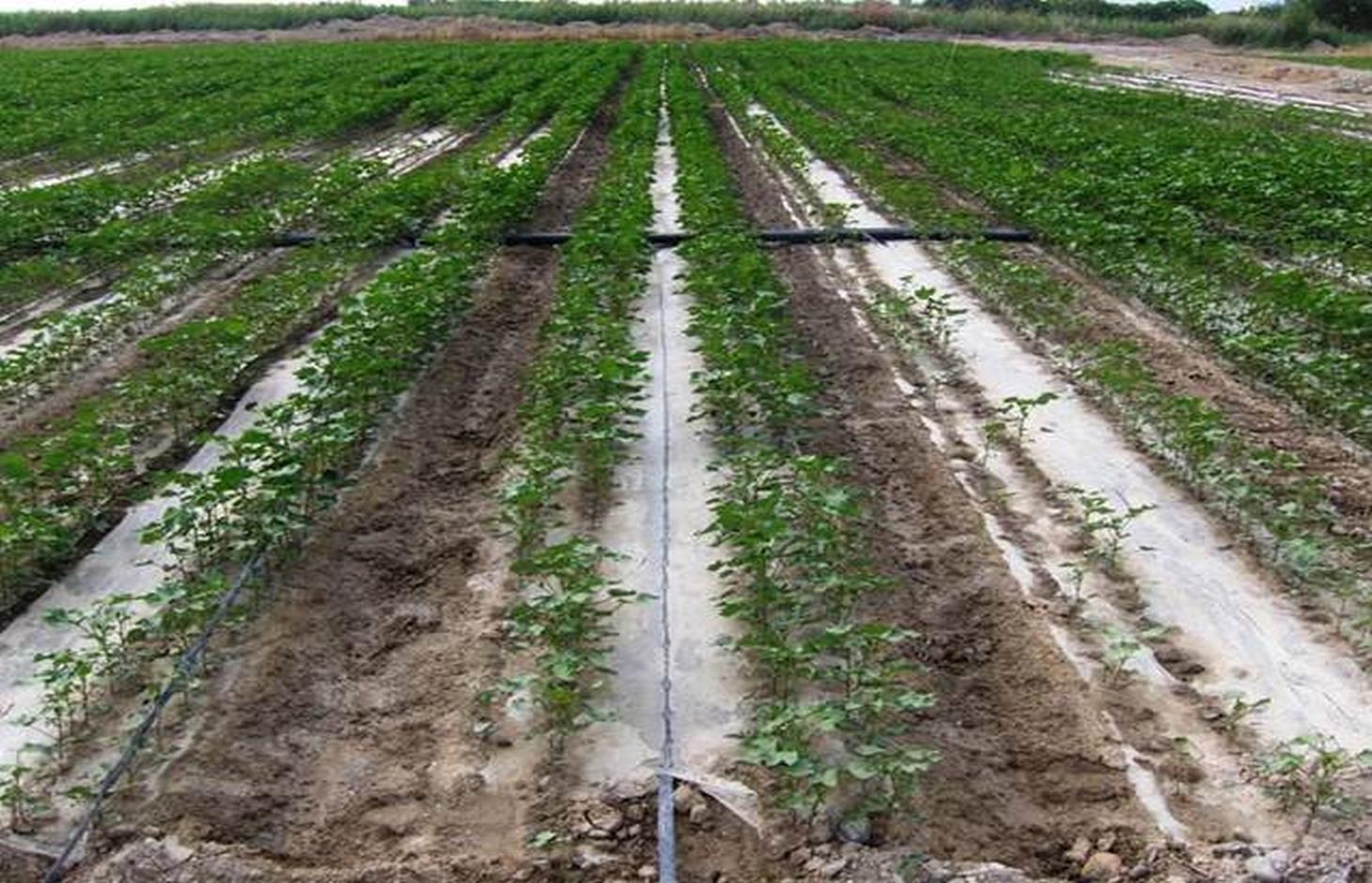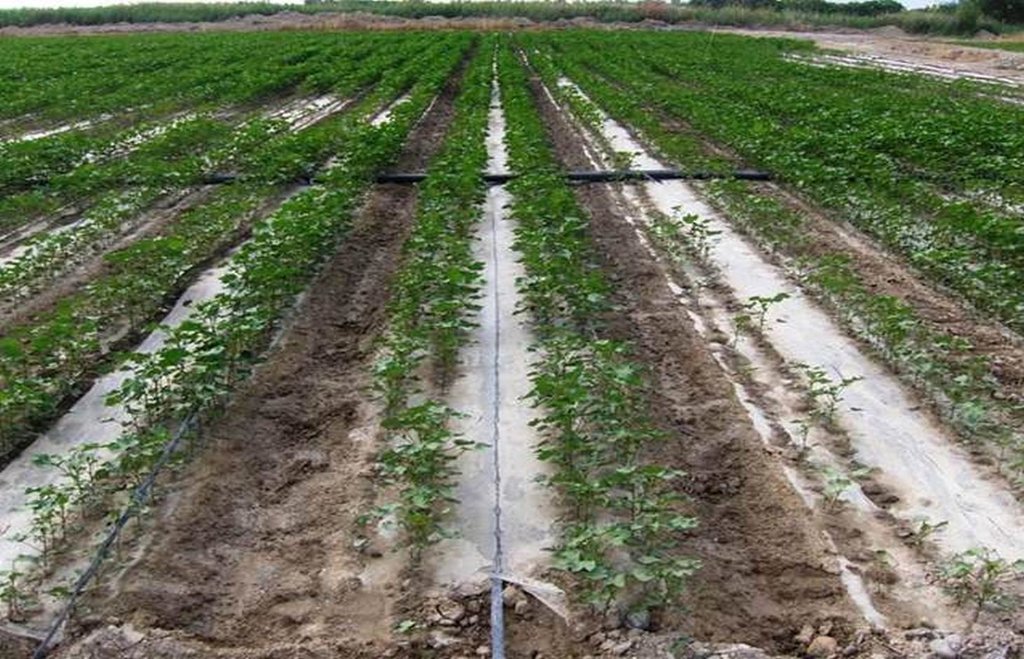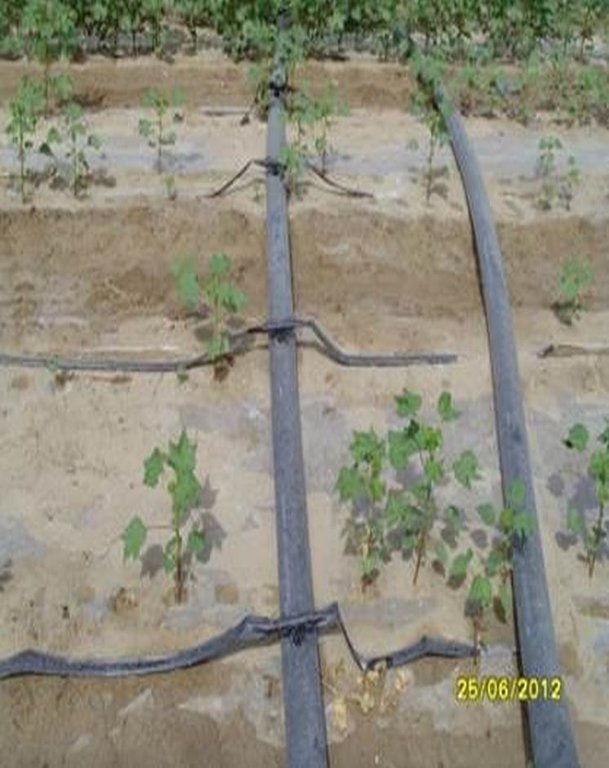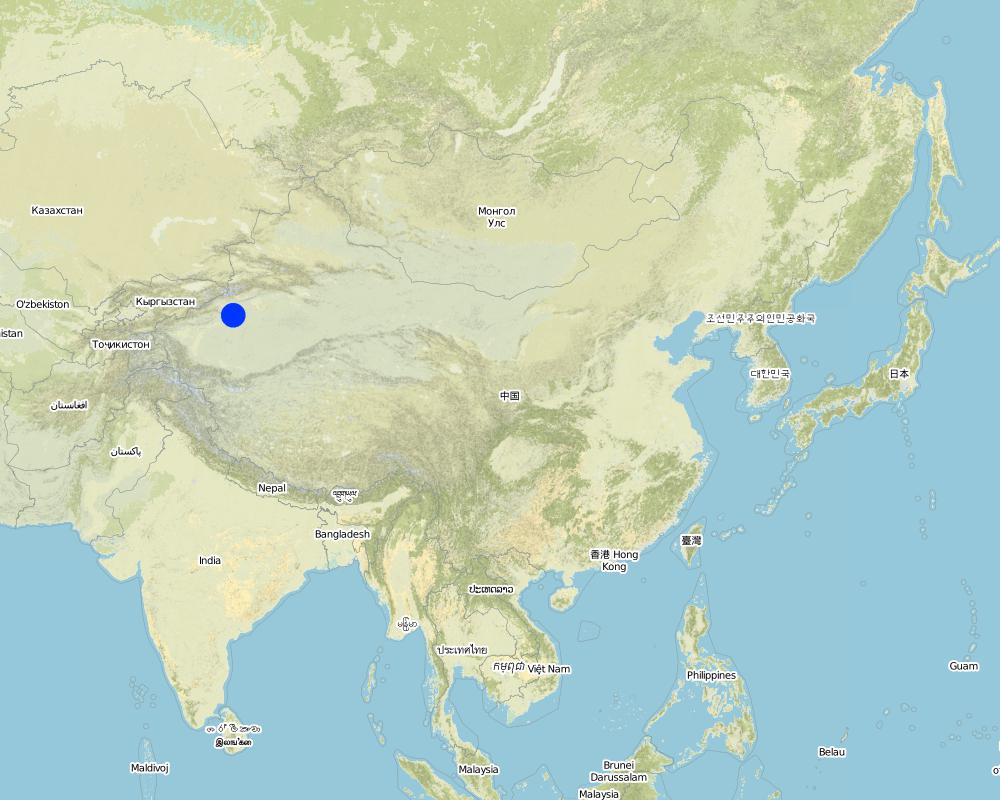Drip irrigation under plastic mulch for cotton production in Xinjiang province, China [Хятад ]
- Шинийг нээх:
- Шинэчлэх:
- Мэдээлэл цуглуулсан: Christian Rumbaur
- Редактор: –
- Хянагчид: David Streiff, Deborah Niggli, Alexandra Gavilano
膜下滴灌 (Chinese)
technologies_1305 - Хятад
- Бүрэн хураангуйг PDF-ээр
- Бүрэн хураангуйг PDF-ээр хэвлэх
- Хөтөч дэх бүрэн хураангуй
- Бүрэн хураангуй (форматгүй)
- Drip irrigation under plastic mulch for cotton production in Xinjiang province, China: 09 3-р сар 2017 (inactive)
- Drip irrigation under plastic mulch for cotton production in Xinjiang province, China: 09 3-р сар 2017 (inactive)
- Drip irrigation under plastic mulch for cotton production in Xinjiang province, China: 04 4-р сар 2018 (inactive)
- Drip irrigation under plastic mulch for cotton production in Xinjiang province, China: 13 3-р сар 2019 (public)
Бүлгүүдийг үзэх
Бүгдийг харуулах Бүгдийг хаах1. Ерөнхий мэдээлэл
1.2 Технологийг үнэлэх, баримтжуулах ажилд хамаарах мэдээлэл өгсөн хүмүүс, байгууллагуудын холбоо барих мэдээлэл
Мэдээлэл өгсөн хүн (с)
ГТМ мэргэжилтэн :
Müller Joachim
University of Hohenheim
Герман
ГТМ мэргэжилтэн :
Zia-Kahn Shamaila
University of Hohenheim
Герман
ГТМ мэргэжилтэн :
Технологи баримтжуулах/үнэлэх ажилд дэмжлэг үзүүлсэн төслийн нэр (шаардлагатай бол)
Sustainable Management of River Oases along the Tarim River, China (SuMaRiO / GLUES)Технологи баримтжуулах/үнэлэх ажилд дэмжлэг үзүүлсэн төслийн нэр (шаардлагатай бол)
Book project: Making sense of research for sustainable land management (GLUES)Технологи баримтжуулах/үнэлэх ажилд дэмжлэг үзүүлсэн байгууллага(ууд)-ын нэр (шаардлагатай бол)
Universität Hohenheim - Герман1.3 WOCAT-аар баримтжуулсан өгөгдлийг ашиглахтай холбоотой нөхцөл
Эмхэтгэгч болон гол мэдээлэгч хүн(хүмүүс) WOCAT аргачлалаар баримтжуулсан мэдээллийг ашиглахтай холбоотой нөхцлийг хүлээн зөвшөөрсөн.
Тийм
2. ГТМ Технологийн тодорхойлолт
2.1 Технологийн товч тодорхойлолт
Технологийн тодорхойлолт:
Drip irrigation under plastic mulch, associated with drainage, to reduce water demand and improve cotton yields in Xinjiang Province, China.
2.2 Технологийн дэлгэрэнгүй тайлбар
Тодорхойлолт:
The dry climate and the long hours of sunshine make Xinjiang especially suitable for production of high quality cotton, and as a result some 40% of China’s cotton is grown here. But there are two main problems: shortage of water and salinization of the soil. Farmers who use the traditional flood irrigation method, and don’t have a drainage system, tend to abandon their fields when they become too saline - and then they look for new land to cultivate. A combination of mulching and drip irrigation can be very effective but still needs careful management. Drip irrigation helps to save water for farmers - and for the environment. But it is still very important to install a drainage system to dispose of surplus water in order to reduce the risk of salinization of the soils. Every four cotton rows are covered with transparent polyethylene film and as a result approximately 80% of the ground surface is covered by the plastic mulch. Plastic mulch and drip lines are placed with a specially equipped tractor.
Purpose of the Technology: Low temperatures and dry soil at sowing, in combination with soil salinity, hinder early plant growth. Plastic mulching increases soil temperature, reduces the need for irrigation, and also helps control salinity in the root zone and suppresses weeds, thereby increasing yields by 10–30% (and improving quality also) (Wang, R. et al., 2011). In the first stages after sowing the climate is particularly cold. With plastic mulching the cotton plants can be sown earlier, because the soil will not cool down during the night as much as without plastic mulch.
Establishment / maintenance activities and inputs: For the establishment of the new technology of drip irrigation under plastic mulch, it is simultaneously essential to install a drainage system to avoid raising the groundwater level and causing salinity. For the installation of the drip lines, the transparent plastic film and the seeding, a tractor and a special tool for the installationis needed: one acre can be installed in a day. After the emerging of the cotton plants, holes must be cut in the plastic film so that the cotton plants can emerge. After harvesting, the drip lines and the plastic film must be collected and recycled. If the plastic is left behind it will pollute the soils and injure livestock if they eat it. Furthermore plastic residues in the soil can reduce subsequent yields, as roots are physically inhibited. After the collection of the plastic residues, if there is no adequate drainage system, the field needs to be flooded to flush the salt layer, which has accumulated below the root zone, deeper into the soil. If the field is not flooded the salt will negatively affect the next years’ cotton plantation.
Natural / human environment: Southern Xinjiang is an arid region with 50 to 90 mm per year. Most precipitation occurs between June and August. It is classified as a temperate cold desert climate. For drip irrigation under plastic mulch, it is principally surface water that is used, which is delivered to the field via channels from reservoirs to the fields. The reservoirs are filled in summer with the floods along the Tarim River. The untreated surface water is of poor quality - for agricultural use only. For drip irrigation, the water needs to be treated to avoid blocking the drip outlets. The overall technology is expensive, and only land user groups and communities can afford the machines and the materials.
2.3 Технологийн гэрэл зураг
2.5 Энэ үнэлгээнд хамрагдсан технологийг хэрэгжүүлсэн улс орон / бүс нутаг / байршил
Улс :
Хятад
Улс/аймаг/сум:
China / Xinjiang Province
Байршлын дэлгэрэнгүй тодорхойлолт:
Tarim River Basin
Технологи өргөн дэлгэрсэн эсхийг тодорхойл:
- газар дээр жигд тархсан
Хэрэв талбайн хэмжээ тодорхойгүй бол талбайн хэмжээг ойролцоогоор тодорхойлно уу.
- > 10,000 км2
Тайлбар:
It might be used also in other provinces. But this not known to the author.
Map
×2.6 Хэрэгжих огноо
Байгуулсан тодорхой оныг мэдэхгүй бол баримжаа хугацааг тодорхойл:
- 10-50 жилийн өмнө
2.7 Технологийн танилцуулга
Тайлбар (төслийн төрөл г.м.):
It is not clear how the technology was invented.
3. ГТМ технологийн ангилал
3.1 Технологийн үндсэн зорилго (д)
- Үйлдвэрлэлийг сайжруулах
3.2 Технологи хэвтрүүлсэн газрын одоогийн газар ашиглалтын хэлбэр(д)
Нэг газр нутгийн хэмжээнд хэрэгжих холимог газар ашиглалт:
Тийм
Газар ашиглалтын холимог тогтолцоог (тарилан/бэлчээр/ой мод) тодорхойл:
- ХАА-н ойжуулалт

Тариалангийн газар
- Нэг наст үр тариа
- Мод, бут тариалах
Тариалан - Таримлыг тодорхойлно уу:
- даавууны таримал - хөвөн
- wheat
Мод, бут тариалах - Таримлыг тодорхойлно уу:
- жимс, бусад
Нэг жил дэх ургамал ургах улирлын тоо:
- 1
Тодорхойлно уу:
Longest growing period in days: 220Longest growing period from month to month: March to October with irrigation
Тайлбар:
major cash crop: cotton
major food crop: wheat
other: fruit trees
Major land use problems (compiler’s opinion): Water use conflicts between agriculture and natural vegetation, soil salinization, desertification.
Major land use problems (land users’ perception): Soil salinization and water shortage.
Future (final) land use (after implementation of SLM Technology): Cropland: Ca: Annual cropping
Livestock is grazing on crop residues
Constraints of wastelands / deserts / glaciers / swamps: water availability, evaporation
3.3 Технологи хэрэгжүүлснээс газар ашиглалтад өөрчлөлт гарсан уу?
Технологи хэрэгжүүлснээс газар ашиглалтад өөрчлөлт гарсан уу?
- Тийм (Технологи хэрэгжүүлэхээс өмнөх үеийн газар ашиглалтын талаархи асуулгыг бөглөнө үү)

Байгалийн ой / модтой газар
- (Сайжруулсан) байгалийн ой/мод бүхий газар
3.4 Усан хангамж
Технологи хэрэгжүүлсэн газрын усан хангамж:
- Бүрэн усалгаатай
3.5 Технологи ГТМ-ийн аль бүлэгт хамаарах
- гадаргын/ ургамал бүрхэвч сайжрах
- урсац өөрчлөх ба урсац бүрдүүлэх
3.6 Технологийг бүрдүүлэх ГТМ арга хэмжээ

Агрономийн арга хэмжээ
- А1: Ургамал/ хөрсөн бүрхэвч

Менежментийн арга хэмжээ
- М2: Ашиглалтын менежмент/эрчимийг өөрчлөх
- M4: Үйл ажиллагааны цаг хугацаанд том өөрчлөлт орно
- M6: Хог хаягдлын менежмент (дахин боловсруулах, эргүүлэх ашиглах эсвэл бууруулах)
Тайлбар:
Main measures: management measures
Secondary measures: agronomic measures
Type of agronomic measures: mulching
3.7 Технологийн шийдвэрлэсэн газрын доройтлын үндсэн төрлүүд

Хөрсний химийн доройтол
- Cs: Давсжилт / шүлтжилт

Хөрсний физик доройтол
- Pw: Усны түвшин нэмэгдэх буюу намагших

Усны доройтол
- Ha: Хуурайшилт
Тайлбар:
Main type of degradation addressed: Cs: salinisation / alkalinisation, Ha: aridification
Secondary types of degradation addressed: Pw: waterlogging
Main causes of degradation: soil management (Most fields have no drainage - Increase of groundwater - salinization of soils), crop management (annual, perennial, tree/shrub) (cotton monoculture), deforestation / removal of natural vegetation (incl. forest fires) (Deforestation to gain new arable land), over abstraction / excessive withdrawal of water (for irrigation, industry, etc.), wind storms / dust storms (Dust storms, blow out of top soil), droughts (It is an arid climate), population pressure (Doubling of population during the last thirty years.), land tenure (Land belongs to the state), poverty / wealth (Family farmers are poorer than city dwellers), education, access to knowledge and support services (Poorer farmers have less access to extension services.)
Secondary causes of degradation: industrial activities and mining (There is oil production in the region, but it was not studied), discharges (point contamination of water) (Non-point source pollution and drainage water discharge from the fields.), disturbance of water cycle (infiltration / runoff) (use of surface and ground water for large scale irrigation), floods (Floods are necessary for the region (riparian forests))
3.8 Газрын доройтлоос урьдчилан сэргийлэх, сааруулах ба нөхөн сэргээх
Газрын доройтолтой холбоотойгоор Технологи ямар зорилго тавьсан болохыг тодорхойл:
- Газрын доройтлыг багасгах сааруулах
Тайлбар:
Main goals: mitigation / reduction of land degradation
4. Техникийн нөхцөл, хэрэгжилтийн үйл ажиллагаа, материал ба зардал
4.1 Технологийн техникийн зураг
Техник тодорхойлолт (техник зурагтай уялдана):
There are double rows of cotton 20 cm apart, with a drip line between. 40 cm then separates each double row. Two double rows are covered by one length of plastic mulch. There is a small strip of bare soil between each length of plastic mulch. Mulch covers around 80% of the soil surface.
Location: Korla City. Xinjiang Province / China
Technical knowledge required for field staff / advisors: moderate (For the easy and fast installation a tractor is needed)
Technical knowledge required for land users: moderate
Main technical functions: improvement of ground cover, increase of biomass (quantity), increase of water use efficiency
Secondary technical functions: improvement of surface structure (crusting, sealing), increase / maintain water stored in soil
Mulching
Material/ species: transparent plastic (Polyethylene), thickness: 0.08 mm
Quantity/ density: 7100 m/ha
Remarks: 1.4 m width in lines with spacing of 20 cm between lines
Change of land use practices / intensity level: Change from flood irrigation to drip irrigation
Major change in timing of activities: Plastic mulch enables early sowing of cotton
Зохиогч:
Shamaila Zia-Khan
4.2 Материал болон зардалд хамаарах ерөнхий мэдээлэл
Үнэ өртөгийг тооцоход ашигласан мөнгөн нэгж:
- Ам.доллар
Хөлсний ажилчны нэг өрдийн ажлын хөлсийг тодорхойл:
1
4.3 Байгуулах үйл ажиллагаа
| Үйл ажиллагаа | Хугацаа (улирал) | |
|---|---|---|
| 1. | Tractor | |
| 2. | Drip line installation, plastic mulch and seeding tool | At sowing |
| 3. | Making holes for the (cotton) plants in the plastic mulch.Maintaining hoses | After emerging |
4.4 Байгуулалтад шаардагдах зардал ба материал
| Хөрөнгө оруулалтыг дурьдана уу | Хэмжих нэгж | Тоо хэмжээ | Нэгжийн өртөг | Материал бүрийн нийт өртөг | % газар ашиглачаас гарсан зардал | |
|---|---|---|---|---|---|---|
| Хөдөлмөр эрхлэлт | Drip line installation | ha | 1.0 | 3.0 | 3.0 | 100.0 |
| Хөдөлмөр эрхлэлт | Machine use | ha | 1.0 | 5.0 | 5.0 | 100.0 |
| Тоног төхөөрөмж | Tractor | Piece | 1.0 | 5000.0 | 5000.0 | 100.0 |
| Таримал материал | seeds | kg | 30.0 | 3.0 | 90.0 | |
| Барилгын материал | Plastic mulch | 1.0 | 32.0 | 32.0 | 50.0 | |
| Барилгын материал | Black dripe lines | Set | 1.0 | 380.0 | 380.0 | 50.0 |
| Технологи бий болгох нийт үнэ өртөг | 5510.0 | |||||
| Технологи бий болгох нийт үнэ өртөг, ам.доллар | 5510.0 | |||||
Тайлбар:
Duration of establishment phase: 0.33 month(s)
4.5 Засвар үйлчилгээ / давтагдах үйл ажиллагаа
| Үйл ажиллагаа | Хугацаа/ давтамж | |
|---|---|---|
| 1. | Ploughing and leveling of field. | Before sowing |
| 2. | Irrigation | |
| 3. | Removal of the drip lines and the plastic mulch |
4.6 Засвар үйлчилгээ / урсгал үйл ажиллагаанд шаардагдах зардал ба материал (жилээр)
| Хөрөнгө оруулалтыг дурьдана уу | Хэмжих нэгж | Тоо хэмжээ | Нэгжийн өртөг | Материал бүрийн нийт өртөг | % газар ашиглачаас гарсан зардал | |
|---|---|---|---|---|---|---|
| Хөдөлмөр эрхлэлт | Collecting mulch | ha | 1.0 | 5.0 | 5.0 | 98.0 |
| Бордоо ба биоцид | Irrigation and flooding water | 1.0 | 8.0 | 8.0 | 100.0 | |
| Технологийг арчилах тордоход шаардагдах нийт үнэ өртөг | 13.0 | |||||
| Технологи сайжруулах нийт үнэ өртөг, ам.доллар | 13.0 | |||||
Тайлбар:
Machinery/ tools: tractor with installation tool for the drip irrigation under plastic mulch, other tools: hoe
The costs for the machine, the plastic hoses and the plastic mulch are calculated above are for 1 ha and were calculated on the basis of 2013 (subsequently costs have risen). Water price: 0.019 CNY/m3. Farmers need 3000 m3 per ha.
5. Хүн, байгалийн хүрээлэн буй орчин
5.1 Уур амьсгал
Жилийн нийлбэр хур тундас
- <250 мм
- 251-500 мм
- 501-750 мм
- 751-1,000 мм
- 1,001-1,500 мм
- 1,501-2,000 мм
- 2,001-3,000 мм
- 3,001-4,000 мм
- > 4,000 мм
Хур тунадасны талаархи тодорхойлолт/ тайлбар:
90 mm per year. Jan, Feb, Apr and May: 3 mm; Mar, Sept: 5 mm; Jun: 33 mm; Jul: 18 mm; Oct: 0 mm; Dec: 8 mm
Агро-уур амьсгалын бүс
- Хуурай
Thermal climate class: temperate. cold desert climate
5.2 Байрзүйн зураг
Дундаж налуу:
- Тэгш (0-2 %)
- Бага зэрэг хэвгий (3-5 %)
- Дунд зэрэг хэвгий (6-10 % )
- Долгиорхог (11-15 %)
- Толгодорхог (16-30 %)
- Эгц налуу (31-60 % )
- Огцом эгц налуу (>60 %)
Гадаргын хэлбэр:
- Тэгш өндөрлөг/тэгш тал
- Зоо, хяр
- Уулын энгэр, хажуу
- Ухаа, гүвээ, дов толгод
- Уулын бэл
- Хөндий, хоолой, нам хотос
Өндөршлийн бүс:
- 0-100 м д.т.д
- 101-500 м д.т.д
- 501-1,000 м д.т.д
- 1,001-1,500 м д.т.д
- 1,501-2,000 м д.т.д
- 2,001-2,500 м д.т.д
- 2,501-3,000 м д.т.д
- 3,001-4,000 м д.т.д
- > 4,000 м д.т.д
Технологи дараах асуудалд хандсан эсэхийг тодорхойл:
- шаардлагагүй
Гадаргын талаархи тайлбар ба бусад тодорхойлолт:
Altitudinal zone: altitudes of 800 to 1300 meters
5.3 Хөрс
Хөрсний дундаж зузаан:
- Маш нимгэн (0-20 см)
- Нимгэн (21-50 см)
- Дунд зэрэг зузаан (51-80 см)
- Зузаан (81-120 cм)
- Маш зузаан (>120 cм)
Хөрсний бүтэц (өнгөн хөрс):
- Сийрэг/хөнгөн (элсэрхэг)
- Дунд зэрэг (шавранцар)
Өнгөн хөрсний органик нэгдэл:
- Бага (<1 % )
Боломжтой бол хөрсний бүрэн тодорхойлолт, боломжит мэдээллийг өгнө үү, жишээ нь хөрсний төрөл, хөрсний урвалын орчин/хүчиллэг байдал, катион солилцох чадавхи, азотын хэмжээ, давсжилт г.м.
Soil fertility: low - medium
Soil drainage / infiltration: medium
Soil water storage capacity: medium high
5.4 Усны хүртээм ба чанар
Хөрсний усны гүн:
5-50 м
Гадаргын усны хүртээмж:
Сайн
Усны чанар (цэвэрлээгүй):
Муу чанарын ундны ус (цэвэршүүлэх шаардлагатай)
Усны чанар, нөөцийн талаархи тайлбар ба бусад тодорхойлолт:
Ground water table: also < 5 m and the installation of drip irrigation under plastic mulch should be installed with a drainage system. If the groundwater table is too high salinisation of the soil will be the result
Availability of surface water: For the drip irrigation under plastic mulch mostly surface water is used. It is diverted by channels to the agricultural fields. There must be a good water availability at the fields.
Water quality (untreated): For the drip irrigation under plastic mulch the water quality must be quite high, otherwise the small holes of the drip lines will be blocked soon.
5.6 Технологи нэвтрүүлсэн газар ашиглагчидын онцлог шинж
Үйлдвэрлэлийн системийн зах зээлийн чиг баримжаа:
- Худалдаа наймааны/ зах зээлийн
Фермээс гадуурх орлого:
- Нийт орлогын %10 доош хувь
Чинээлэг байдлыг харьцангуй түвшин:
- Чинээлэг
- Маш чинээлэг
Хувь хүн эсвэл бүлэг:
- бүлэг / олон нийтийн
Механикжилтын түвшин:
- Хүнд хүчир ажил
Хүйс:
- Эрэгтэй
Газар ашиглагчдын бусад шаардлагатай шинж чанарыг тодорхойл:
Land users applying the Technology are mainly common / average land users
Difference in the involvement of women and men: Man are doing the earth works in the fields, women do more the harvesting
Population density: 10-50 persons/km2
Annual population growth: > 4%; 7%
5% of the land users are very rich and own 10% of the land (income from large fields of cash crops).
20% of the land users are rich and own 30% of the land (income from cash crops (fruits, cotton)).
40% of the land users are average wealthy and own 30% of the land (income from cash crops (fruits, cotton)).
30% of the land users are poor and own 20% of the land.
5% of the land users are poor and own 10% of the land.
Off-farm income specification: Farmers who have not implemented the drip irrigation under plastic mulch also generate off-farm income.
Manual labour: harvesting
5.7 Технологи нэвтрүүлэхэд газар ашиглагчийн ашигласан газрын дундаж талбай
- < 0.5 га
- 0.5-1 га
- 1-2 га
- 2-5 га
- 5-15 га
- 15-50 га
- 50-100 га
- 100-500 га
- 500-1,000 га
- 1,000-10,000 га
- > 10,000 га
Энэ нь жижиг, дунд, том оворт тооцогдох уу (орон нутгийн чиг баримжаагаар)?
- Дунд-хэмжээний
Тайлбар:
5-15 ha: state farms
< 0.5 ha: family farmers
5.8 Газар эзэмшил, газар ашиглах эрх, ус ашиглах эрх
Газар өмчлөл:
- Төр засаг
Газар ашиглах эрх:
- Нэгдлийн хэлбэрээр (зохион байгуулалттай)
- Түрээсийн хэлбэрээр
Ус ашиглах эрх:
- Нэгдлийн хэлбэрээр (зохион байгуулалттай)
- Түрээсийн хэлбэрээр
Тайлбар:
All the land belongs to the state. Farmers have the right to use the land for 70 years.
5.9 Дэд бүтэц, үйлчилгээний хүртээмж
эрүүл мэнд:
- Ядуу
- Дунд зэргийн
- Сайн
боловсрол:
- Ядуу
- Дунд зэргийн
- Сайн
техник дэмжлэг:
- Ядуу
- Дунд зэргийн
- Сайн
хөдөлмөр эрхлэлт (жишээ нь, ХАА-аас өөр):
- Ядуу
- Дунд зэргийн
- Сайн
зах зээл:
- Ядуу
- Дунд зэргийн
- Сайн
эрчим хүч:
- Ядуу
- Дунд зэргийн
- Сайн
зам ба тээвэр:
- Ядуу
- Дунд зэргийн
- Сайн
ундны ус ба ариутгал:
- Ядуу
- Дунд зэргийн
- Сайн
санхүүгийн үйлчилгээ:
- Ядуу
- Дунд зэргийн
- Сайн
6. Үр нөлөө ба дүгнэлт
6.1 Технологийн талбай дахь үр нөлөө
Нийгэм-эдийн засгийн үр нөлөө
Үйлдвэрлэл
Газар тариалангийн үйлдвэрлэл
Тайлбар/ тодорхой дурьдах:
15% of more cotton yield
Усны хүртээм ба чанар
усалгааны усны хэрэгцээ
Орлого, зарлага
ХАА-н хөрөнгө оруулалтын зардал
Нийгэм-соёлын үр нөлөө
Нийгэм, эдийн засгийн хувьд эмзэг бүлгийнхний нөхцөл байдал
Livelihoods and human well-being
Экологийн үр нөлөө
Усны эргэлт/ илүүдэл
ууршилт
Хөрс
хөрсөн бүрхэвч
хөрс алдагдах
давсжилт
Бусад экологийн үр нөлөө
salinization below root zone
6.2 Технологийн талбайн гадна үзүүлсэн үр нөлөө
Усны хүртээмж
салхиар тээвэрлэгдэх хурдас
6.3 Технологийн уур амьсгалын өөрчлөлт ба Уур амьсгалаас хамаарах аюул/гамшигт үзэгдэлд өртөх байдал ба эмзэг байдал (газар ашиглагч нарын дүгнэлтээр)
Уур амьсгалын аажим өөрчлөлт
Уур амьсгалын аажим өөрчлөлт
| Улирал | Өсөх эсвэл буурах | Технологи түүний нөлөөг хэрхэн бууруулж байна? | |
|---|---|---|---|
| Жилийн дундаж температур | Өсөлт | Сайн |
Уур амьсгалаас хамаарах аюулууд (гамшигууд)
Цаг уурын гамшигууд
| Технологи түүний нөлөөг хэрхэн бууруулж байна? | |
|---|---|
| Орон нутгийн аадар бороо | Сайн биш |
| Орон нутгийн салхин шуурга | Сайн |
Уур амьсгалын гамшигууд
| Технологи түүний нөлөөг хэрхэн бууруулж байна? | |
|---|---|
| Ган гачиг | Сайн |
Гидрологийн гамшиг
| Технологи түүний нөлөөг хэрхэн бууруулж байна? | |
|---|---|
| усны үер (гол) | Сайн биш |
Бусад уур амьсгалд хамаарах үр дагаварууд
Бусад уур амьсгалд хамаарах үр дагаварууд
| Технологи түүний нөлөөг хэрхэн бууруулж байна? | |
|---|---|
| Ургалтын хугацаа багасах | Сайн |
6.4 Зардал ба үр ашгийн шинжилгээ
Үр ашгийг барилга байгууламжийн зардалтай (газар ашиглагчдын үзэл бодлоор) хэрхэн харьцуулах вэ?
Богино хугацаанд эргэн төлөгдөх байдал:
Бага зэрэг сөрөг
Урт хугацаанд эргэн төлөгдөх байдал:
Эерэг
Үр ашгийг засвар үйлчилгээ/ урсгал зардалтай (газар ашиглагчдын үзэл бодлоор) хэрхэн харьцуулах вэ?
Богино хугацаанд эргэн төлөгдөх байдал:
Бага зэрэг сөрөг
Урт хугацаанд эргэн төлөгдөх байдал:
Эерэг
6.5 Технологи нутагшуулах
Боломжтой бол, тоогоор илэрхийл (өрхийн тоо эсвэл бүрхэх талбай):
No number on households
Тайлбар:
100% of land user families have adopted the Technology with external material support
Comments on acceptance with external material support: The government gives subsidies to the farmers who are installing the drip irrigation under plastic mulch.
There is a little trend towards spontaneous adoption of the Technology
Comments on adoption trend: The government want to spread the technology in the whole region by giving subsidies to the farmers.
6.7 Технологийн давуу тал/боломжууд
| Газар ашиглагчдын тодорхойлсон давуу тал/боломжууд |
|---|
|
helps to save water thus saves costs. How can they be sustained / enhanced? It is subsidies by the government. |
| Эмхэтгэгч, бусад мэдээлэл өгсөн хүмүүсийн өнцгөөс тодорхойлсон давуу тал/боломжууд |
|---|
|
It helps to save water during the vegetation period and thus helps to reduce the conflicts between the upstream and downstream farmers. How can they be sustained / enhanced? The technology (drip + mulch) needs to be supplemented by installing a drainage system in the fields otherwise there will be a build-up of salinity and farmers will abandon land and move on. |
6.8 Технологийн дутагдалтай/сул тал/аюул болон тэдгээрийн хэрхэн даван туулах арга замууд
| Эмхэтгэгч, бусад мэдээлэл өгсөн хүмүүсийн өнцгөөс тодорхойлсон сул тал/ дутагдал/ эрсдэл | Тэдгээрийг хэрхэн даван туулах вэ? |
|---|---|
| Salinization of the soils is increasing The consequence is that the fields are flooded after harvest in November/December to leach out the salt. The water used for drip irrigation plus the water to flush the salts to lower soil layers add up to almost the same amount as if farmers were using the original flood irrigation technology. | drainage system in the fields required. |
7. Ном зүй ба холбоосууд
7.1 Мэдээллийн аргууд / эх сурвалжууд
7.2 Хүртээмжтэй ном, бүтээлийн ишлэл
Гарчиг, зохиогч, он, ISBN:
Zia-Khan,S., Spreer, W., et al. Effect of dust deposition on stomatal conductance and leaf temperature of cotton in Northwest China.
Хаанаас авч болох вэ? Зардал?
Water 2015, 7, 116-131; doi: 10.3390/w7010116. www.mdpi.com/journal/water open access.
Холбоос ба модулууд
Бүгдийг харуулах Бүгдийг хаахХолбоосууд
Холбоос байхгүй байна
Модулууд
Модуль байхгүй байна






